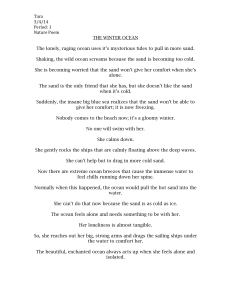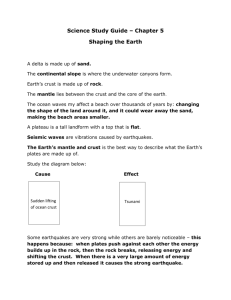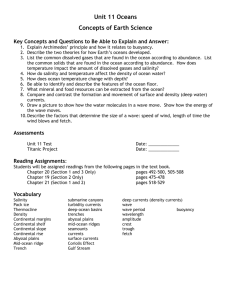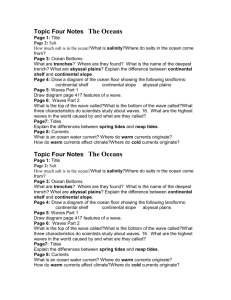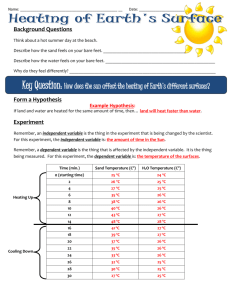Oceans Study Guide 2010 answers
advertisement
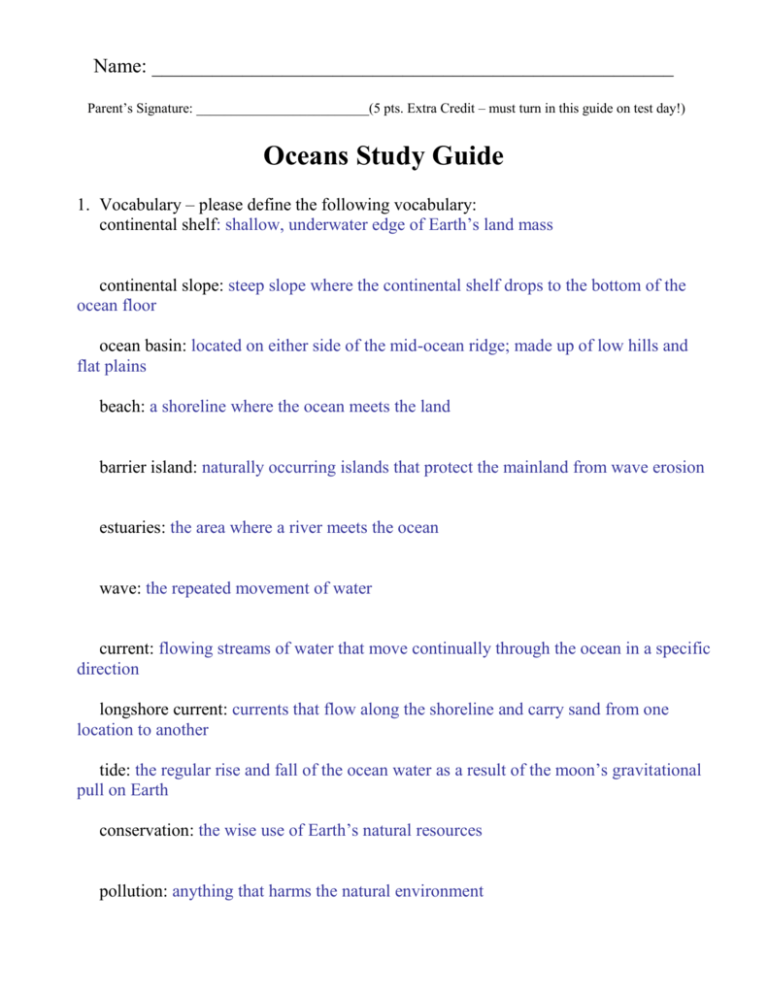
Name: ____________________________________________________ Parent’s Signature: _________________________(5 pts. Extra Credit – must turn in this guide on test day!) Oceans Study Guide 1. Vocabulary – please define the following vocabulary: continental shelf: shallow, underwater edge of Earth’s land mass continental slope: steep slope where the continental shelf drops to the bottom of the ocean floor ocean basin: located on either side of the mid-ocean ridge; made up of low hills and flat plains beach: a shoreline where the ocean meets the land barrier island: naturally occurring islands that protect the mainland from wave erosion estuaries: the area where a river meets the ocean wave: the repeated movement of water current: flowing streams of water that move continually through the ocean in a specific direction longshore current: currents that flow along the shoreline and carry sand from one location to another tide: the regular rise and fall of the ocean water as a result of the moon’s gravitational pull on Earth conservation: the wise use of Earth’s natural resources pollution: anything that harms the natural environment 2. Complete the comparison chart of continental and oceanic landforms with the appropriate landform. Continental and Oceanic Landforms Description Continental Oceanic Low land between hills Valley Rift or mountains Deep valley with high, Canyon Trench steep sides An opening in the surface Volcano Seamount and from which lava flows Volcanic Islandsexample: Hawaiian Islands Land which rises high Mountain Range Mid-ocean ridge above the ground Wide, flat areas of land Plains Abyssal Plain 3. Complete the following chart to explain how tides, waves, currents, and storms change or affect beaches, barrier islands, estuaries, and inlets. Effects of tides, waves, currents, and storms on the Ocean Shore Zone Beaches Barrier Islands Estuaries Inlets Bring in sand, Bring in sand, Brings in Tides Amount of shells, sediments shells, sediments sediments and water changes Waves Currents Storms and leave them behind and leave them behind Weather and erode shoreline; can deposit sand Move sand from one place to another Cause wave action that removes sand Changes Deposit sand shape of BI by in estuaries deposition Move sand from one place to another Cause wave action that removes sand sea life that feed life in estuary X Cause wave action that removes sand X Change shape of opening Change shape of opening 4. Use your notes to complete the comparison of waves, currents, and tides. Comparison of waves, currents, and tides (How Water Moves) How it moves What it looks What causes it Effect on land like Waves Through the On-shore Deposits and water, but winds erodes sand does not carry on shore it Longshore -Like a river Prevailing currents: running through Surface Winds Carries sand away ocean Currents Changes shape of -carries the water -curves and bends around landforms Tides Rise and fall barrier islands and inlet openings Gravitational pull of moon Water level changes 5. What is the purpose of the following conservation efforts? Jetties: to keep sand from washing into the inlet opening and blocking it Groins: to keep sand from eroding on the beach Sea Walls: to protect structures on the shoreline Fences: to keep people from destroying sand dunes and it also helps some with keeping sand from being washed away Planting of Sea Oats: to create a “web of roots” on sand dune to keep the sand in place Beach Renourishment: bringing in sand from ocean floor helps to keep the natural flow of ocean waves from damaging the structures on the shore 6. Please explain how pollution has affected the ocean and land? (List examples.) o Dumping materials into rivers (which will eventually go into the estuaries and oceans) o Smoke and fumes from burning fuels pollutes the air o Oil spills harm the ocean and kills ocean life o Carelessness in agriculture, industry, construction, and mining 7. Use drawings and words to explain how the moon’s gravitational pull affects Earth’s tides. 8. On the drawing of the wave below, please label: crest, trough, wave length, wave height (amplitude).
